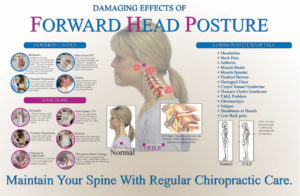DAMAGING EFFECTS OF FORWARD HEAD POSTURE
Forward Head Posture (FHP) affects our health negatively. Not only does it cause neck and back pain, it decreases lung capacity, mood, headaches and even blood pressure. Many of these health issues can be improved or eliminated by correcting our posture. Repetitive movements in a certain direction will strengthen nerve and muscle pathways to move that way more readily.
We live in a world where we face forward more than ever due to use of computers, mobile devices, cell phones and video games. 
Ideally, the head should sit directly on the neck and shoulders, like a golf ball sits on a tee. The weight of the head is more like a bowling ball than a golf ball, so holding it forward, out of alignment, puts a strain on your neck and upper back muscles. The result can be muscle fatigue and all to often an aching neck. Because the neck and shoulders have to carry this weight all day is an isometric contraction, this causes neck muscles to lose blood , get damaged, fatigue, strain, cause pain, burning and fibromyalgia. When spinal tissues are subject to a significant load for a sustained period of time, they deform and undergo remodeling changes that could become permanent. This is why it takes time to correct FHP. In addition, FHP has been shown to flatten the normal neck curve, resulting in disc compression, damage and early arthritis. This abnormal position is also responsible for many tension headaches, often termed carcinogenic headaches. FHP also causes tension in the TMJ (temporomandibular joint) or jaw joint, leading to pain, headaches and bite problems. Some evidence exists that postural positions can affect the nerve tissue by altering blood flow to the spinal cord.(6) People with uncorrected FHP can potentially suffer chronic or unpleasant conditions such as, pinched nerves and blood vessels, like thoracic outlet syndrome, muscle and tissue pain, syndromes like fibromyalgia, chronic strains and early degeneration and arthritis.
SOLUTIONS
- The first step in correction is to be examined and x-rayed by a chiropractor to identify the exact measurements of the FHP. Once that is established, a specific corrective care program for FHP is given, including adjustments and specific exercises. The chiropractor will point out poor ergonomics and situations that predispose you to FHP and give you practical solutions.
- For office use and video game play, place your computer monitor height so the top third of the screen is even with your eyes and the screen is 18” – 24” from your face. Support the lower back. If children sit on the floor looking upward, have them use a floor pillow armchair and sit up straight.
- Every 20-30 minutes, sit up straight and pull the neck and head back over the shoulders. Hold for a count of 3 and do 15-20 reps. Alternatively, stand against a wall with a small pillow at your midback, move your head back to touch the wall, hold for a count of 3 and do 20-25 reps.
- Always use a back support pillow when sitting or driving. By supporting the low back, the head and neck will move back over the shoulders.
- At home, lay face down on the floor and extend your head and shoulders up, while pinching your shoulder blades together. Hold for a count of 3 and do 15-20 reps.
- Backpacks – maximum backpack weight should be 15% of the child’s weight. Never wear backpacks over one shoulder. Always use a waist belt, and if available, a chest belt to neutralize the load. Without these belts, the head will move forward to compensate for the load. A new type of backpack with an air bladder has been shown to significantly reduce weight without a strap.
Monitoring good posture is essential for optimum health. With a little effort and a chiropractor on your health team, you can be assured a future doing things you love to do rather than suffering from damage and degeneration that poor posture can bring.